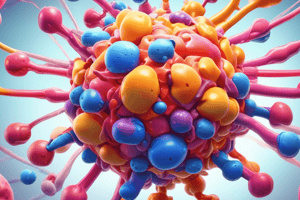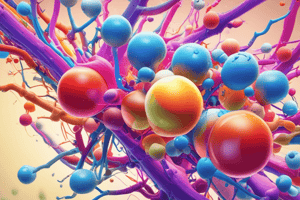Podcast
Questions and Answers
What is the main function of enzymes in a chemical reaction?
What is the main function of enzymes in a chemical reaction?
- To help enzymes denature when needed
- To decrease the activation energy and speed up the reaction (correct)
- To become part of the product after the reaction
- To consume reactants in the reaction
Which enzyme classification involves the rearrangement of atoms?
Which enzyme classification involves the rearrangement of atoms?
- Lyase
- Isomerase (correct)
- Transferase
- Oxidoreductase
What happens to enzyme activity when exposed to extreme temperatures or pH levels?
What happens to enzyme activity when exposed to extreme temperatures or pH levels?
- It becomes more specific
- It increases
- It decreases (correct)
- It remains unchanged
What type of molecule is ATP?
What type of molecule is ATP?
Which process produces the MOST ATP in glucose catabolism?
Which process produces the MOST ATP in glucose catabolism?
What is common to all 3 pathways of carbohydrate catabolism?
What is common to all 3 pathways of carbohydrate catabolism?
How are aerobic and anaerobic respiration different from each other?
How are aerobic and anaerobic respiration different from each other?
What has happened to the 6 carbons that were part of the glucose molecule by the end of Krebs cycle?
What has happened to the 6 carbons that were part of the glucose molecule by the end of Krebs cycle?
How many total FADH2 have been made by the end of Krebs cycle?
How many total FADH2 have been made by the end of Krebs cycle?
What is the main function of an enzyme in a chemical reaction?
What is the main function of an enzyme in a chemical reaction?
What is a substrate in the context of enzyme action?
What is a substrate in the context of enzyme action?
Which of the following is a characteristic of enzymes?
Which of the following is a characteristic of enzymes?
What is the role of coenzymes in enzyme action?
What is the role of coenzymes in enzyme action?
What is the main function of a coenzyme in an enzymatic reaction?
What is the main function of a coenzyme in an enzymatic reaction?
How do enzymes speed up chemical reactions?
How do enzymes speed up chemical reactions?
What is the primary role of an enzyme in a chemical reaction?
What is the primary role of an enzyme in a chemical reaction?
Which molecule classification do coenzymes, such as NAD+ and FAD, belong to?
Which molecule classification do coenzymes, such as NAD+ and FAD, belong to?
Study Notes
Enzymes and Chemical Reactions
- The main function of enzymes is to speed up chemical reactions by lowering the activation energy required for the reaction to occur.
- Enzymes that involve the rearrangement of atoms are classified as isomerases.
Enzyme Activity
- Extreme temperatures and pH levels can denature enzymes, leading to a significant decrease in enzyme activity.
- Denaturation causes the enzyme's active site to change shape, making it unable to bind to its substrate.
ATP and Energy Production
- ATP (Adenosine Triphosphate) is a high-energy molecule that provides energy for various cellular processes.
- The process of oxidative phosphorylation produces the most ATP in glucose catabolism.
Carbohydrate Catabolism
- Common to all 3 pathways of carbohydrate catabolism (glycolysis, Krebs cycle, and electron transport chain) is the breakdown of glucose to produce energy.
Aerobic and Anaerobic Respiration
- Aerobic respiration occurs in the presence of oxygen, producing a net gain of 36-38 ATP molecules.
- Anaerobic respiration occurs in the absence of oxygen, producing a net gain of 2 ATP molecules.
Krebs Cycle and ATP Production
- By the end of the Krebs cycle, the 6 carbons from the original glucose molecule have been converted into CO2, ATP, NADH, and FADH2.
- A total of 2 FADH2 molecules are produced by the end of the Krebs cycle.
Enzyme Action and Substrates
- A substrate is the molecule that an enzyme binds to and catalyzes a chemical reaction with.
- Enzymes act as biological catalysts, speeding up chemical reactions without being consumed by the reaction.
- Enzymes are highly specific, meaning they only bind to specific substrates.
Coenzymes and Enzyme Action
- Coenzymes, such as NAD+ and FAD, are molecules that assist enzymes in catalyzing chemical reactions.
- The main function of a coenzyme is to facilitate the transfer of electrons or functional groups during enzymatic reactions.
- Coenzymes belong to the molecule classification of nucleotides.
Studying That Suits You
Use AI to generate personalized quizzes and flashcards to suit your learning preferences.
Description
Test your knowledge about catabolic and anabolic reactions, energy requirements, and enzymes in cellular metabolism. This quiz covers the examples of catabolic and anabolic processes, the role of enzymes as biological catalysts, and their interaction with substrates.



